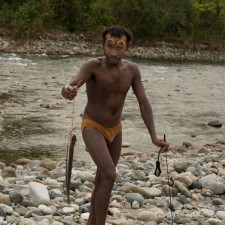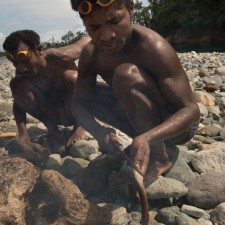I am currently enrolled in the Master of Arts in Professional Communication at Royal Roads University in Victoria, British Columbia, Canada. I am a self-taught, amateur photographer. Travelling and photography are two of my passions in life. Travelling is another way for me to learn and widen my perspective; it enables me to gain a broader worldview and embrace new cultures, while photography is my creative outlet and complements my passion for travelling. I enjoy capturing portraits of people; I am captivated by the courage, dignity and spirit of the people I meet through the lens of my camera.
My submission is part of a larger project, which consisted of spending three months living in Northern Luzon, Philippines, as part of my master’s research and thesis. My project entailed conducting a visual ethnography in a remote area near the Blos River on the eastern side of the Northern Sierra Madre mountain range. A project of this magnitude and scope is a first for me. As part of my final thesis project, I self-published a book, which portrays a representation of shared stories, formed relationships, and embodied experiences from the six weeks I spent conducting fieldwork.
I decided to focus my research on the inhabitants dwelling near the Blos, because they are vulnerable and continue to face increasing pressure from logging operations and large-scale agricultural expansion. In a world where speed is at the core of modernization and immediacy, we often consider alternatively mobile lifestyles as being stuck in the past. However, as the world continues to experience an increased amount of waste and pollution, I think it is important to learn from communities whom tread a little less lightly on the earth.
Inhabitants dwelling near the Blos live along the coasts and tropical rainforests within the Northern Sierra Madre Natural Park, a protected area under the jurisdiction of the Department of Environment and Natural Resources. This particular region is the largest protected area in the Philippines, as it covers the last undisturbed lowland dipterocarp rainforest. The Northern Sierra Madre Natural Park has been minimally affected by modern cultures and access to this region is limited. Currently, there are no roads that connect the region to mainland Luzon. The four coastal towns of Palanan, Maconacon, Divilacan, and Dinapigue are only accessible by sea or propeller plane.
Inhabitants living near the Blos rely heavily on hunting, gathering, and small-scale agriculture as their main source of livelihood. There is no running water, or electricity, and there is no cellular reception or Internet connection. Most of the inhabitants dwelling in this region left mainland Luzon in search of better opportunities to cultivate the land. They yearn to adopt rural lifestyles that afford them the availability of space, and opportunities for a sustainable life. Being removed from mainland Luzon enables these communities to maintain a strong sense of community, locality, and place.
However, in the summer of 2012, the Filipino government approved the construction of a major highway to traverse the Northern Sierra Madre Mountain range from Ilagan to Divilacan. The proposed road, spanning more than 50 kilometers, will traverse the vast, verdant and dense ridges of the Northern Sierra Madre mountain range. Often, roads are viewed as a social good, offering a sense of freedom, social equality, and increased connectivity and interaction; however, I argue that road-based mobilities are not inherently good. Road building, for example, causes deforestation, which is threatening the livelihoods of the river- and coastal-dwelling inhabitants.
For centuries, the coastal- and river-dwelling inhabitants have cultivated distinct and viable alternatives to the contemporary culture of acceleration. Dwellers in these remote communities are attuned to the environment as they make their way through it. Inhabitants dwelling near the Blos River have learned how to skillfully run across the river’s shore and predict when a storm is rolling in. They rely on the skills and knowledge attained from years of living here.
With the continued pressure to construct a major highway to traverse the Northern Sierra Madre mountain range, it is important to consider that road infrastructures are not inherently good. The notion of a road as a conduit that cuts like a knife through the verdant, vast and dense ridges that are rich with species and habitat is a fitting analogy when we envision what will happen to the landscape and the resources these communities depend upon for their livelihood.
Through the textual and visual depictions presented here, I hope to portray signs of hope, a strong sense of community and friendship, and an essence of simple living. More specifically, I hope to reflect how inhabitants dwelling near the Blos River have cultivated viable and sustainable communities. However, I also aimed to show the struggles and challenges the inhabitants dwelling near the Blos endure as they continue to experience poverty, marginalization, resource exploitation, and political instability. [Official Website]


























